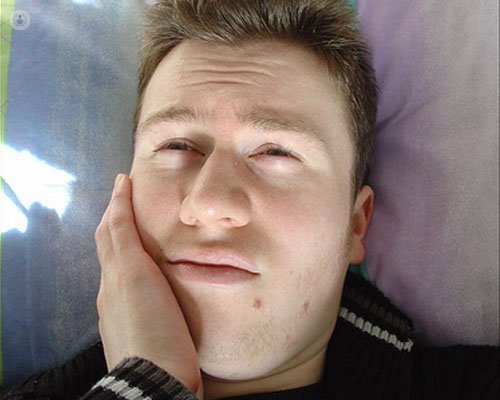All you need to know about wisdom teeth
Written by:Wisdom teeth are the last molars appear in the mouth (3rd molar). Its eruption is at the beginning of adult life, hence its name grindstone judgment of sanity molar or wisdom tooth.
They take their name from the ancient belief that, due to their late eruption, people have more sense than when they are children, age when the rest of the dentition appears.
Does everyone have wisdom teeth?
Between 85-98% of young adult patients have agenesis of third molars or wisdom teeth, that is, the lack thereof.
This special behavior of the third molar is due to a problem of adaptation of the masticatory system to our habits, where cultural evolution plays a predominant role over the biological.
With this foregoing, we mean that our current diet is much softer than the wild diet of primitive man, therefore, we have adapted to this and as a result, the working space of bone to inhabit the teeth is reduced greater proportion than the tooth size, which induces the appearance of dental crowding.
Agenesis act as evolutionary mechanism and this fact would be a solution to this problem blind. Most often affect the rearmost tooth, wisdom tooth being the tooth with higher prevalence of tooth agenesis or absence.

Do you have to always remove the wisdom teeth?
In the society in which we surround ourselves it is very common that we know a high percentage of friends, family and colleagues who have gone through the extraction of wisdom teeth. While this may make us think that generally the wisdom teeth should be removed, but not always.
Wisdom teeth may be located in different positions, both in depth and angulation in the bone, which will help the decision therapeutic approach or abstention. prior careful planning to make a wise decision regarding the treatment plan is necessary.
So, besides a good radiographic study it will be necessary to evaluate different aspects such as age, symptoms, medical and surgical history, as well as making a correct anamnesis based on intra and extra exploration.
Regarding wisdom teeth that are asymptomatic, no objective criteria that allow us to know the evolution will continue, so keep an expectant attitude with regular checks, except in the following cases:
- Patients who are to undergo radiotherapy
- Third molars under dentures
- Eruptive partially erupted wisdom teeth with completed capacity (risk of infection)
- To reduce the risk of fractures of the mandibular angle (especially in young individuals who practice extreme sports)
- Online chordal preventing fracture fragment fixation
- In area chordal tumor resection • online chordal osteotomy orthognathic surgery necessary for
- In cases of early loss of the 1st and 2nd molar.
- Autologous the molar 3ºr position of a 1 molar lost prematurely.
Cordales before presenting symptoms, the correct therapeutic approach is removal. These cases are:
- infections
- Wisdom teeth with cavities with significant destruction
- Tailpieces associated with tumors and cysts
- Wisdom teeth with root resorption
- Causing chordal resorption cavities or distally 2nd molar
- atypical facial pain
What symptoms and complications have wisdom teeth?
The eruption of wisdom teeth occurs in outbreaks, ie, the patient reports a period of discomfort that normally usually lasts around a week, followed by an asymptomatic or mild discomfort period until new outbreak. This symptom is normal.
The tailpiece may well erupt completely his crown, cases where symptoms generally will not be different from those discussed above on its normal eruption, erupt partially or. In this case, the tailpiece can be entirely or partially enclosed gum, more likely being possible for these additional to its normal eruption symptoms.
A different case would be the tailpiece quedase included within the bone; here you should take an expectant attitude and monitor their progress with periodic radiographic controls by chance that in the future submit pathology.
As mentioned above, are the wisdom teeth semierupcionados those who are most frequently associated with the onset of symptoms, being the pericoronaritis the first presenting symptom and clinical manifestation often associated with third molar retention. Pericoronitis is an acute infectious process characterized by inflammation of the mucosal tissues surrounding the partially erupted tooth.
From a pathogenic point of view, it is easy to understand that, finding the crown partially covered molar, is relatively common for food impaction occurs, which together with the difficulty to clean properly the area, makes pathogens such as streptococci , staphylococci and spirochetes find a suitable means for its development, and therefore production pericoronaritis.
Pericoronaritis treatment of inflammatory and analgesics will be by and in case of drainage, antibiotics will be necessary to "cool the acute process". Once past the acute, the surgeon will decide whether to take an expectant attitude or extraction indicates tailpiece.
What is the ideal age to remove wisdom teeth?
There is no ideal age, although it is an important parameter. It is shown that over 25 years the rate of complications increases significantly. However, if we compare age groups between 9 and 17 years and between 17 and 24 years, the rate of complications is practically the same.
Do wisdom teeth move teeth when they leave?
The debate for or against prophylactic removal of lower third molars to prevent the onset or increase of anterior dental crowding has had much controversy.
The mechanism by which the eruption of the 3th molars was attributed the origin of late crowding the previous sector would be the mesial push (forward) teething transmitted through the points of interproximal contact, so scroll ball billiard.
Some authors argue that the wisdom teeth "exert pressure from behind", and at the same time argue that the development of postpubertal Crowding is multifactorial, ie, which do not justify the widespread prophylactic removal of these teeth as their role is not too important.
In most adults, although it was previously undergone orthodontic treatment, some degree of overcrowding seen in lower incisors.
Currently, the only possible role in the lower anterior crowding would be the tendency for mesial migration of teething. We know that is present in the 1st molar in ages coincident with the eruption of the 3rd molar.
Therefore, the 3rd lower molar eruption may be a factor in the occurrence of late crowding to collaborate in the mesial migration of teething. However, we have no data to defend this.
Thus, we can conclude that the extraction of the lower wisdom teeth to prevent anterior crowding or orthodontic relapse would not be indicated.
What is the extraction of wisdom teeth?
The extraction of a wisdom tooth is a procedure that can be performed in the dental office for a period not exceeding 1 hour.
The procedure is carried out under local anesthesia. Only in very specific indications should be done under general anesthesia:
- Inclusions very deep, ectopias and heterotopias (away from its usual position), where the surgical technique is different from the usual
- Patients with mental disabilities (lack of collaboration)
- Patients with extreme anxiety
- Patients with poliinclusiones (several impacted teeth), although this would be an "indication of"
While general anesthesia technique should be considered as "second line" because of the possible complications of the technique, and the need for hospitalization of patient in clinic for at least 24 hours.
If the patient needed more than an extraction, ideally appointments are separated in a period of 10-15 days, or you can remove one side (ipsilateral upper and lower), and the next week first, extracting the other two on the contralateral side.
How is postoperative removal of wisdom teeth?
Postoperative after extraction of a wisdom tooth is very versatile. Depends on various factors such as patient age, position and inclination of the tailpiece, associated pathology, surgical technique, medication taken by the patient, concomitant diseases, among others. Thus, the postoperative patient will vary and the surgical technique, also knowing that the pain is a subjective symptom completely.
It is normal for blood wound slightly during the first 24 hours, the stained Saliva may appear. It is also expected some pain, swelling and difficulty in mouth opening. Do not be alarmed if the face appears swollen the next day, and may even be normal and increased inflammation to occur 3 days after surgery.
The patient should be advised before any circumstance that is outside the above mentioned as normal, and should contact the dentist .
Besides all this, the hours following surgery, the patient must follow a series of measures:
- Immediately after surgery, keep biting sterile gauze on the surgical area during 30min - 1h
- Apply cold on the skin at the height of the mandibular angle at short intervals (10 min) during the first 24 hours
- Not spit or rinse during the first 24 hours
- Do not eat during 4-6h after extraction. Keep cold liquid or soft preferably room temperature or diet.
- Avoid smoking and drinking alcohol the following days
- Avoid driving immediately after the intervention and physical exercises perform work or important the next few days.
- Sleeping with the head in a position higher than the rest of the body (pillows)
- Brush all teeth normally possible, except in the area of intervention during the first days. subsequently brushed smooth in the area.
- The following day, rinsed with water and salt or mouthwash diluted in water (0.12% chlorhexidine), or alternately both.
- Maintaining proper oral hygiene both pre- and postoperative (It helps minimize the risk of postsurgical complications)
The patient must also follow the guidelines of medication prescribed by your surgeon, being habitual taking an antiinflamatoriio and rescue analgesic. Taking antibiotics post-intervention will be necessary in certain circumstances, not a general rule.


